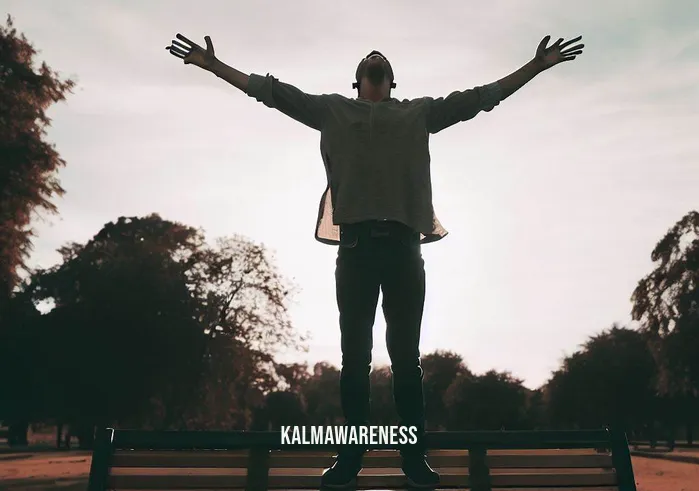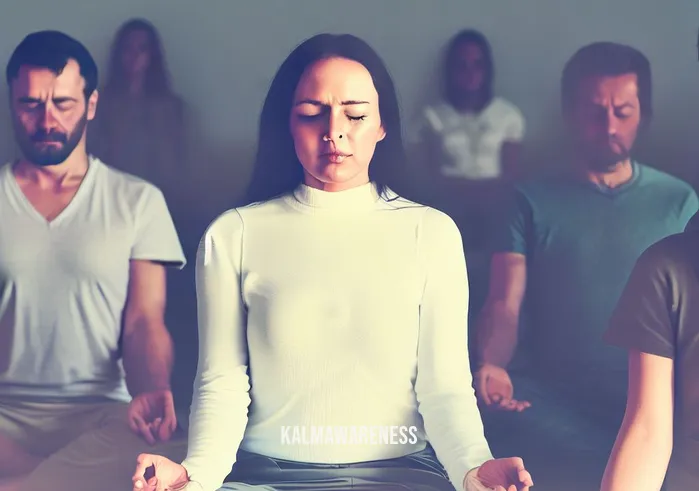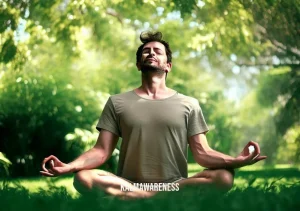Can You Meditate While Lying Down? Exploring the Pros and Cons
What is Lying Down Meditation?
The realm of mindfulness and relaxation techniques offers a plethora of options for those seeking mental peace. Traditionally, meditation is practiced while sitting upright, often cross-legged, in a setting free from distractions. However, the modern, hectic lifestyle has led many to ponder alternative approaches to this ancient practice. One such approach is lying down meditation. This raises the question, “Can you meditate while lying down?”
While some purists argue that lying down compromises the quality of your meditation, there are valid reasons to consider this method, especially if you struggle with sitting for extended periods. In this context, understanding how to spell “stabilize” your body and mind becomes crucial when switching positions.
Advantages of Lying Down Meditation
Here are some pros to lying down while meditating:
- Physical Comfort: It is easier for those who have back issues or joint pain to start a meditation practice while lying down.
- Ease into Sleep: Mindful movement sleep practices often recommend a prone position to transition seamlessly into rest.
- Convenience: You can do this anywhere you find a flat surface, which means you’re more likely to stick to a daily routine.
Deeper Relaxation
Sometimes, sitting upright can make you overly aware of your posture, thereby defeating the purpose of meditation, which involves attaining a peaceful state of mind in which thoughts are not occupied by worry. Lying down can lead to a quicker sense of relaxation and even help you understand how we get deep so fast.
“In a prone position, the body naturally feels more at ease, enabling the mind to dive deeper into a meditative state.“
Drawbacks of Lying Down Meditation
However, it’s essential to keep in mind some disadvantages:
- Risk of Falling Asleep: This is perhaps the most common issue. For some, a 15-minute power nap might be more beneficial than a meditation session if they are feeling particularly tired.
- Lack of Alertness: The level of attention may not be the same as when sitting up.
The Traditional Perspective
From a traditional standpoint, lying down to meditate could be seen as diverging from the judgement of the wise. In many Eastern practices, the upright sitting position is seen as an element of some meditation exercises, thought to align the body’s chakras and promote focused mindfulness.
The Verdict: It’s Up to You
If you’ve considered the pros and cons and are still keen on lying down while meditating, go ahead and give it a try. There are no hard and fast rules in the realm of sustainable self-care. Your personal comfort is paramount, and if lying down enables you to meditate more effectively, then that’s the method for you.
However, if you’re a beginner looking for straightforward guidance, Jack Kornfield’s meditation for beginners is a great place to start. For those looking to mix things up, rouse yoga or EMDR meditation can offer new avenues to explore.
In the next segment, we’ll delve deeper into techniques to make lying down meditation more effective. From understanding your body’s signals to mastering the art of breath control, these tips will ensure that you get the most out of your meditation sessions. So, if you’re interested in knowing more about meditation made simple, continue reading.

Techniques for Effective Lying Down Meditation
Exploring Various Approaches
As we dive deeper into the subject of whether you can meditate while lying down, it becomes evident that this method is more than just an alternative—it’s a valid approach that caters to specific needs and lifestyles. Techniques range from simple mindfulness exercises to complex routines that can incorporate elements of mindful hypnobirthing or even teenagers walking meditations.
Tailoring Meditation to Your Needs
Understanding that meditation is a flexible practice is vital. This is especially true in a world where we’re constantly encouraged to “touch that body part” as part of self-awareness exercises, but seldom get the time to actually pause and do it. Lying down to meditate allows you to explore different techniques, some of which can be exceptionally relaxing and beneficial.
List of Techniques for Lying Down Meditation
- Body Scan: Start at the toes and work your way up, observing sensations in each body part.
- Guided Imagery: Listen to a narrative that takes you on a mental journey, ideally one that fosters peace and tranquility.
- Deep Breathing: Focus your attention on your breath, noting how your abdomen rises and falls.
- Mantra Repetition: Choose a word or phrase that resonates with you and repeat it either aloud or in your mind.
- Music Meditation: Play some gentle tunes that can amplify the relaxing effect, particularly those with 256 Hz benefits.
| Technique | Benefits | Best for |
|---|---|---|
| Body Scan | Enhanced body awareness, pain relief | Those with chronic pain or stress |
| Guided Imagery | Stress reduction, improved focus | Individuals with a vivid imagination |
| Deep Breathing | Calmness, improved lung capacity | Anyone looking to improve focus and respiratory health |
| Mantra Repetition | Spiritual connection, mental clarity | Those seeking a spiritual aspect to their meditation practice |
| Music Meditation | Emotional balance, cognitive benefits | People who connect deeply with music |
Dealing with Common Challenges
While lying down meditation offers several advantages, there are potential drawbacks to consider. However, as with any meditation practice, the more you do it, the easier it becomes to avoid common pitfalls like inadvertently falling asleep or losing focus. One way to counter these challenges is to set an intention before you begin. This act alone can stabilize your practice.
Take It One Day at a Time
There’s a lovely sentiment that resonates well with the journey of mindfulness: one for each blessed day. Instead of rushing to achieve a ‘perfect’ meditation session, relish each moment as it comes. In meditation, as in life, it’s the journey that counts, not the destination.
What’s Coming Next
In the next chapter, we will delve into the science behind lying down meditation. How does it affect your brain waves, hormones, and overall wellbeing? We’ll also discuss its relevance in special conditions like pregnancy and for those involved in intense physical activities. So, if you’ve ever wondered about the tangible benefits of asking, “Can you meditate while lying down?”—stay tuned. The insights might just prompt you to make this a regular part of your sustainable self-care regimen. Continue reading to elevate your understanding and practice of lying down meditation.

Unlocking the Inspirational Power of Lying Down Meditation
A Well of Untapped Potential
When exploring the query, “Can you meditate while lying down?”, it becomes increasingly evident that there is a wealth of untapped potential in this seemingly straightforward question. The mere act of lying down to meditate may at first seem like just another form of relaxation. Still, upon closer inspection, it reveals itself to be a conduit for self-discovery and inspiration. It’s about making mindfulness and introspection a part of our daily rituals, as much as mindful movement to induce sleep or a 15-minute power nap for rejuvenation.
Words of Wisdom
“The quieter you become, the more you can hear.” – Ram Dass
When you commit to prone meditation, you tap into a peaceful state of mind that allows for richer, deeper thoughts and sensations. As you continue to integrate this practice into your life, you may find that you become more open to the voices of inspiration and wisdom.
“Meditation is not evasion; it is a serene encounter with reality.” – Thích Nhất Hạnh
In the calm of lying down meditation, you’re not running away from your problems. Rather, you’re quietly facing them with a judgment of the wise, allowing for a level of introspection that’s often hard to attain.
“In stillness, the world resets.” – Anonymous
The grounding nature of meditation while lying down aligns well with this anonymous quote. This unique form of meditation lets you pause, reflect, and possibly reset your world, especially when you keep in mind its transformational power.
Exploring the Avenues of Inspiration
Lying down to meditate creates a conducive environment for both the mind and body to explore new avenues of inspiration. One might say that the postural ease of being prone facilitates a deeper connection to our innermost thoughts, much like the element of some meditation exercises where stillness serves as a catalyst for enlightenment.
In a world where we’re often told to keep moving, the act of lying down to meditate becomes a powerful statement. It’s a declaration that stillness, too, has immense value. When you permit yourself to be still, you give your mind permission to wander and your soul the freedom to soar.
The Ripple Effect
Embracing this form of relaxation meditation doesn’t merely impact you on a personal level. Its influence can ripple through your relationships and contribute to a more harmonious existence. Imagine how life might look if we all took a moment to breathe deeply and clear our thoughts—very much like what’s achieved through a rousing yoga session, but in a more subdued form.
Charting the Course for the Next Chapter
As we journey through the multidimensional world of lying down meditation, we’ve discussed its techniques and now its inspirational power. In the next chapter, we’ll look at how to take your lying down meditation practice to the next level. We will explore advanced techniques, address potential pitfalls, and offer tips for those looking to deepen their practice further. So, if you’re intrigued by the promises and possibilities that come with answering “yes” to the question, “Can you meditate while lying down?”, stay tuned. The revelations in the following chapter may just become the cornerstone of your sustainable self-care strategy.
Whether you’re a novice seeking a simple meditation for beginners or an advanced practitioner aiming to get deep so fast, the practice offers a range of experiences and benefits that can inspire. So let’s continue this exploration and further unlock the inspirational potential of lying down meditation.

Deconstructing the Layers of Lying Down Meditation
Unpacking the Nuances
The question of “Can you meditate while lying down?” opens the door to a multitude of deeper inquiries that warrant careful scrutiny. As we further delve into the intricacies of prone meditation or supine mindfulness—however you wish to term it—we discover that it’s more than just a form of mindful hypnobirthing or a quick EMDR session. It’s an expansive realm offering myriad benefits and possible pitfalls that you need to be aware of.
Probing the Benefits
At this point, you may be wondering why you should incorporate this lying-down approach into your routine, especially when there are so many different ways to spell stabilize your life and achieve equilibrium. The reasons are multifold:
- Physical Comfort: Unlike other forms, prone meditation takes the pressure off your back and joints.
- Deeper Relaxation: Lying down promotes a rapid transition into a peaceful mental state, facilitating the body’s own healing processes.
- Sleep Enhancement: This form of meditation can serve as a perfect prelude to a power nap or even a night of restorative sleep.
- Ease of Practice: You can do it virtually anywhere—whether you’re out walking as teenagers do or taking a break at work.
Potential Pitfalls to Consider
Yet, as enriching as lying down meditation can be, it comes with its own set of challenges:
- Drowsiness: One of the most common issues, especially if you are new to meditation made simple.
- Distraction: The comfort may lead your mind to wander toward daily concerns rather than meditative focus.
- Physical Limitations: For some, lying down might exacerbate certain conditions, like back pain or respiratory issues.
Weighing in the Scientific Insights
You may also find interest in what science has to say about prone meditation. Studies indicate that specific frequencies like 256 Hz may offer additional therapeutic benefits during meditation. When you lie down to meditate, incorporating such frequencies can enhance your experience by:
- Aligning your body’s natural rhythms
- Promoting cellular regeneration
- Reducing anxiety and stress levels
Setting the Stage for the Final Act
As we prepare to round out our comprehensive look at lying down meditation, we’ve covered its techniques, its inspirational value, and now its complexities. You’re now well-equipped with information and might be curious to know how you can make lying down meditation a part of your sustainable self-care strategy.
In the next chapter, we’ll be pulling all these threads together, offering a synthesized guide that will allow you to embark on or refine your journey into the world of lying-down meditation. We’ll discuss ways to integrate it seamlessly into your lifestyle, whether you’re a busy professional, a parent, or someone just looking for a bit of serenity amidst life’s chaos.
So, if you’re ready to take your lying-down meditation practice from a question to a transformative experience, stay tuned. The concluding chapter promises to provide the final pieces of this fascinating puzzle.

Resting Your Way to Mindfulness: The Final Word on Lying Down Meditation
Summing Up the Journey
What an enlightening voyage we’ve undertaken together! Starting from the foundational aspects to unpacking the complexities, we’ve explored nearly every facet of the question, “Can you meditate while lying down?” We’ve looked into the scientific benefits, the inspirational nuggets, and even the best practices to make lying-down meditation a robust part of your sustainable self-care regimen.
Revelations and Takeaways
Our inquiry has led us through various avenues, each offering unique perspectives on prone or supine meditation. From its role in enhancing mindful movements in sleep to how it can involve attaining a peaceful state of mind, we’ve come to appreciate its vast potential. This form of relaxation is more than a passing trend; it’s a facet of a holistic lifestyle that encourages mindfulness in every posture and situation.
The Wisdom Unearthed
It’s interesting to note that even ancient teachings mirror our conclusions. In the Judgement of the Wise, this form of stillness is considered an elemental aspect of meditation exercises. The guiding principle is simple: Mindfulness can be achieved in every position; it’s the intent and focus that count.
A Call to Action
There’s a world of wisdom out there, and this chapter is just the tip of the iceberg. Our discussion doesn’t have to end here. If you’re excited about diving even deeper into topics like these, why not explore the other intriguing articles in our magazine? Perhaps you’d find the exploration of Rouse Yoga to be the perfect complement to your newfound interest in lying-down meditation.
A Heartfelt Thank You
As we wrap up our journey, I’d like to extend a heartfelt thank you for your time and curiosity. Your engagement fuels our commitment to bring you even more enlightening content in future editions. Rest assured, the quest for knowledge and personal growth never ends. There’s always another layer to peel back, another corner to explore, and a new insight to greet each blessed day.
Looking Ahead
In the spirit of ongoing exploration, you can anticipate more comprehensive discussions, not just about how we get so deep, so fast into meditative states, but also other methods for achieving serenity and balance in your life. After all, each of us is a student on a lifelong journey toward mindfulness, peace, and well-being.
As you move forward, remember that the practice of lying-down meditation is as limitless as your imagination. If there’s anything we’ve established, it’s that lying down to meditate is not just a possibility; it’s an enriching practice that welcomes everyone—regardless of age, experience, or lifestyle.
So, why wait? Lay back, breathe deep, and let the journey to inner peace begin.




